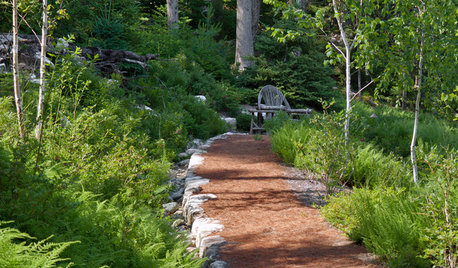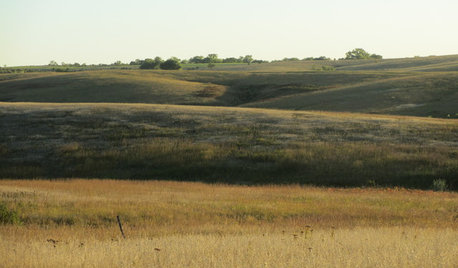Should I mulch or bag my grass clippings?
eddie_il
15 years ago
Featured Answer
Sort by:Oldest
Comments (38)
skoot_cat
15 years agoRelated Discussions
Can I use grass clippings as mulch for fruit trees?
Comments (16)grass (fresh) can and does mat into a giant plug of garbage. the nitrogen load can be an issue (Harbin you're part right, but when do you put a half-pound of fertilizer on the ground? one can easily add that much or more dried weight grass, so the excess N2 can be an issue.... that said, if you put it on green and wet my main issue has been that it can form this giant, stinky plug nothing else gets past--as mentioned, rain sloughs off it. Nothing grows through it, and things in the middle can be over-fed or suffocated by it. Grass can mulch, but too much can be a disaster. Drying it is the best solution I've seen thus far....See MoreSudden bonanza of cut grasses. Should I compost or mulch?
Comments (1)I should add that this stuff has been growing wild - it's not grass clippings like you would get off a lawn... it has significant woody stalks and stems from the reeds in it. I'm wondering it it might be a bit hazardous underfoot if I was to mulch it into my existing grass. On the flipside, I know compost doesn't have a huge amount of nutritional value. So mulching green matter in does appeal on that front....See MoreShould I worry about chemicals in grass clippings?
Comments (10)I think there is now a legal requirement that herbicides and pesticides must break down after they are applied. So, chemicals such as DDT are no longer allowed. The process is called mineralization. Usually it is measured at the site of application; if it is applied to a lawn, the persistence of the chemical is measured in the soil where it was applied. The process of breaking down the chemicals is typically via bacteria, so the presence of organic material that is decomposing affects the rate of decomposition of the chemical. Composting will, of course, speed the breakdown of these sorts of chemicals. My compost takes about two years to complete. So it becomes a judgement call. If you are comfortable knowing that lawn chemicals are designed to break down via bacteria, then you might be ok with other people's grass clippings if you compost it for a couple of years. Obviously, if you use lawn chemicals on your own lawn, you will know when they were last applied. You might want to dispose of the grass clippings right after a chemical application....See MoreMulched with grass clippings, grass sprouts everywhere
Comments (11)Bermuda grass is not the only type of grass that can create these sorts of "weed" problems, although it does have a reputation for being one of the worst. A great many other common turf grass species can display this trait. Turf grasses come in three different growth habits -- clumpers, rhizomatous and stoloniferous -- and most common lawn blends, both warm and cool season grasses, combine a variety of both. Bentgrass, Kentucky blue and creeping ryegrass -- all of which are common to various cool season grass mixtures -- are either rhizomatous or stoloniferous and can create rooting, weedy problems when applied as a mulch to a planting bed. There are a number of other various grass species as well that will create similar issues. Bermuda and Zoisya grass are well known for this problem as well and they tend to be used most often in warmer climates (warm season grasses) and often as a single species rather than as part of a blend of various turf grasses....See Moreegghead2004
15 years agoparafly9
15 years agobpgreen
15 years agocolonel428
15 years agoallison1888
15 years agoeddie_il
15 years agorhizo_1 (North AL) zone 7
15 years agogreenpastures
15 years agoskoot_cat
15 years agojdgt225innh
15 years agopaulinct
15 years agojimtnc
15 years agodanielwells8_hotmail_com
14 years agobpgreen
14 years agowrager
14 years agoddod
14 years agorcnaylor
14 years agobpgreen
14 years agoddod
14 years agodchall_san_antonio
14 years agobpgreen
14 years agojeannie7
14 years agobpgreen
14 years agoddod
14 years agobpgreen
14 years agoGTAnthony
9 years agoUser
9 years agoGTAnthony
9 years agoUser
9 years agoUser
9 years agoGTAnthony
9 years agobeckyinrichmond
9 years agoUser
9 years agoUser
9 years agoGTAnthony
9 years agoUser
9 years ago
Related Stories

GARDENING GUIDESNew Ways to Think About All That Mulch in the Garden
Before you go making a mountain out of a mulch hill, learn the facts about what your plants and soil really want
Full Story
GARDENING GUIDESHow to Pick a Mulch — and Why Your Soil Wants It
There's more to topdressing than shredded wood. Learn about mulch types, costs and design considerations here
Full Story
GARDENING GUIDES5 Things to Know About Weeding and Mulching Your Native Garden
What’s the best time to pull weeds? How thick should the mulch be? Here’s the scoop for a healthy landscape
Full Story
LANDSCAPE DESIGNIs It Time to Consider Fake Grass?
With more realistic-looking options than ever, synthetic turf can be a boon. Find the benefits and an installation how-to here
Full Story
FUN HOUZZEverything I Need to Know About Decorating I Learned from Downton Abbey
Mind your manors with these 10 decorating tips from the PBS series, returning on January 5
Full Story
GARDENING GUIDESGarden Myths to Debunk as You Dig This Fall and Rest Over Winter
Termites hate wood mulch, don’t amend soil for trees, avoid gravel in planters — and more nuggets of garden wisdom
Full Story
MOST POPULARMeet a Lawn Alternative That Works Wonders
Carex can replace turfgrass in any spot, is low maintenance and adjusts easily. Add its good looks and you’ve got a ground cover winner
Full Story
GRASSESHow to Rock a Lawn
Weekend Project: The key to healthy grass begins with the soil. If turf works for you, here’s how to fix it and keep it looking its best
Full Story
GROUND COVERSGround Force: 10 Top Ground Covers for Your Garden
Protect your soil from weeds and drought this summer with a living mulch of ground covers
Full Story
GARDENING GUIDESHow to Get Your Prairie On
Have a field day with your landscape, even if you've got just a few modern containers on a paved path
Full Story


okcdan